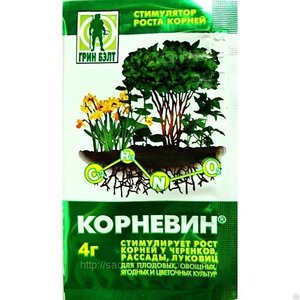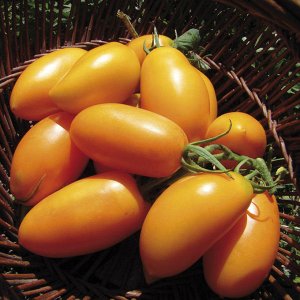Versatile and easy-care miniature tomatoes "Honey Fingers": grown wisely
Why do gardeners love the honey fingers tomato variety? Firstly, for its unpretentiousness in care and sweet appetizing aroma, and secondly, for its resistance to diseases and versatility in application. In addition, tomatoes of this variety look great in the garden, in salads and canning.
Let us consider in more detail the characteristics and description of the Honey fingers variety, yield and other distinctive features.
The content of the article
Description of the variety
The variety is small-fruited, it is grown both in the open field and in greenhouses... Honey fingers is a hybrid, appeared as a result of the merger of other tomato varieties. As befits a hybrid, it has a high immunity to diseases and insect pests.
Distinctive features
Bushes indeterminate, that is, they are not limited in growth. The height of the bush is about 1.5 m. They are easy to care for, but they need regular garters and pinching. Otherwise, the stems will break due to the many ripe tomatoes. Honey fingers is a mid-season variety, summer residents harvest about 100 days after planting.
Fruit characteristics and yield
The fruits have an elongated rounded shape, the average weight of one varies from 50 to 80 g. The color is attractive, yellow-orange. The pulp is juicy, tasty, honey-pink in color. The skin is of medium density, smooth.
Honey fingers it high-yielding varietyDuring the season, gardeners consistently receive about 14 kg of vegetables from 1 sq.m.

How to grow seedlings
Experienced gardeners prepare seedlings 55-60 days before planting in the ground. To prepare seedlings of high quality and resistant to external factors, a number of simple but important rules are followed.
Seed preparation
 They purchase hybrid seeds only from trusted sellers, carefully read the recommendations and tips for growing. To begin with, the seeds are disinfected using the drug "Maxim" or "Fitosporin". For several hours, the material is placed in a liquid, during which time the agent kills dangerous bacteria on the surface of the seeds.
They purchase hybrid seeds only from trusted sellers, carefully read the recommendations and tips for growing. To begin with, the seeds are disinfected using the drug "Maxim" or "Fitosporin". For several hours, the material is placed in a liquid, during which time the agent kills dangerous bacteria on the surface of the seeds.
After that, the material is checked for germination: seeds are poured into a jar of water and stirred clockwise. Those seeds that have sunk to the bottom are suitable for seedlings. The rest of the copies are thrown away.
Then the seeds are germinated. This is necessary so that when planting in the ground, young and not yet strong seedlings do not freeze. For germination, use a wet bandage or cotton pad, in which the seeds are wrapped. For the fastest growth, use the growth stimulator "Kornevin". It has a beneficial effect on the development of the root system and increases the plant's immunity.
Capacity and soil
For seedlings, they use: wooden boxes, flower pots, peat tablets and even cardboard milk cartons. The main thing is to thoroughly wash and dry the container before planting. The containers must have drainage holes. It is better to store containers on special pallets, on the windowsill.
As soil, use ready-made soil or land from the garden. In the second case, it is the composition of soil, peat, wood ash and sawdust (in a ratio of 4: 1: 1: 1). Such a mixture must be disinfected with a solution of potassium permanganate or boric acid.Ideal soil for seedlings should be loose and nutritious, with the necessary acidity.
Sowing
Prepared soil is poured into a clean container, lightly tamped. At a distance of 10-15 cm from each other, small pits are made, placed in them seed... Sprinkle with earth on top and watered abundantly with settled water at room temperature. The seedlings are stored in the warmest and lightest place in the house.
Attention! Keep seedlings away from small children or pets.
Growing and care
 So that the seedlings do not die and do not stretch ahead of time, but develop in stages and correctly, gardeners observe a few simple rules:
So that the seedlings do not die and do not stretch ahead of time, but develop in stages and correctly, gardeners observe a few simple rules:
- watered every 5 days with warm filtered water;
- never use cold tap water;
- 10 days after planting, the first organic feeding is organized;
- mineral complexes are added every 2 weeks;
- use the growth stimulator "Zircon";
- maintain an air temperature of at least 22 degrees;
- organize for seedlings a daylight hours of at least 9 hours;
- 2 weeks before planting, the seedlings are hardened, for example, they are taken out every day for a couple of hours on the balcony.
How to grow tomatoes
Hybrid Honey fingers shows high productivity on sandy loam nutrient soils. To make the tomatoes tasty, they pay great attention to the planting site.
Landing
Since autumn, the beds are dug up and burned all the garbage. It is best to plant tomatoes after cabbage and legumes; it is not recommended to use cucumber or potato beds. In the spring, before planting, the earth is dug up again, a layer of straw is lined or humus is added. Planting begins on a calm, cloudy morning: grooves are made in the garden, the distance between which is 40-50 cm.
Since the variety needs a garter, a wooden peg is installed near each hole. 1-2 seeds are placed in each hole, sprinkled with earth and moistened.
Care
For watering 1 bush use 1-2 liters of water. The amount of watering depends on the weather conditions. In dry and hot summers, tomato beds are watered every 5-7 days, with cool and rainy ones every 10 days.
It is important that the water falls directly under the root, and not on the stem and leaves, otherwise the risk of developing fungal diseases and viral infections increases.
Periodically, the bushes are watered not with water, but with a solution of nettle or onion peel. These folk remedies protect honey fingers from pests and improve the taste of tomatoes.
Important! Traditionally, the beds are loosened before watering to improve oxygen access to the roots and make the soil more nutritious. Together with loosening, weeds are removed, which interferes with the healthy development of honey fingers.
Obligatory care step - mineral and organic feeding... The hybrid develops well if it is fertilized once every 2-3 weeks with liquid manure, ash, yeast, Zdraven. Especially the variety is positively influenced by nitrogen-containing fertilizing, without which it is impossible to get a rich harvest.
Features of cultivation and possible difficulties
Since the bushes of honey fingers are not limited in growth, they are tied to supports. Most often these are the wooden stakes mentioned above, to which the stems are tied with strips of fabric.
The main thing is not to tie the fabric into a knot, otherwise the fragile stems may break. Thanks to tying, all the nutrients that the plant receives from fertilizing go to the development of the tomatoes, and not to the growth of the stem.
Tomatoes every 2 weeks stepchildren, that is, they remove excess shoots from the bushes. Experienced gardeners recommend doing this with gloves, since tomatoes have acrid greens, which stain their hands and have a negative effect on the skin. Excessively long processes are removed using small scissors.
Diseases and pests
 Even strong and resistant to negative factors hybrids are occasionally attacked by insect pests.Many gardeners notice huge whiteflies in the beds with Honey Fingers, which gather on the inner side of the leaf and suck the sap from the plant.
Even strong and resistant to negative factors hybrids are occasionally attacked by insect pests.Many gardeners notice huge whiteflies in the beds with Honey Fingers, which gather on the inner side of the leaf and suck the sap from the plant.
As a preventive measure, spraying with soapy water is used, which includes 100 g of grated soap and 10 liters of warm water. The procedure is carried out once a week.
Sometimes Honey fingers get sick with root rot, which appears due to excessive moisture, an excess of nitrogen-containing dressings. Root rot destroys the roots, which soon causes the bush and fruits to die.
To prevent rot, summer residents treat the beds with ash and mortar potassium permanganate.
Important! The most common tomato disease is recognized late blight... It appears as brown spots. This is a dangerous fungus that can destroy the entire crop. To avoid it, they follow the planting rules, disinfect seeds and soil in time. If the tomato is already sick, then the infected bushes are eliminated, and the remaining ones are sprayed with a solution of Bordeaux liquid.
The nuances of growing in open ground and in a greenhouse
When grown in a greenhouse, gardeners regularly ventilate the structure. The point is that the greenhouse climate is specific. High humidity is observed, which can become a fertile soil for the development of dangerous microbes. The shelter is ventilated with the help of special vents. Particularly increased attention is paid to the microclimate in hot summers.
When growing honey fingers in the open field, it is important to give the plant all the necessary vitamins and trace elements in time. If this is not done, the leaves will take on a sluggish appearance, begin to curl. After a while, the fruits will also lose their firmness and taste. Ash, potassium magnesium, ammonium nitrate are used as mineral fertilizers.
Harvesting and application of the crop
Harvest vegetables as they ripen. As soon as the harvest begins to give the first results, the fruits are picked every 3-5 days. For long-term storage, the variety Honey fingers is picked at maturity, when they are just beginning to acquire a yellowish tint. The fruits are not washed with water, but simply wiped with a dry cloth and stored in a cool dry place.
The Honey Fingers variety makes mouth-watering side dishes, fresh and pickled salads, cold spicy snacks, sandwiches. Sweet and juicy taste harmoniously combines with meat and fish, vegetables and spices. Moreover, tomatoes are delicious and fresh.
Interesting! Due to their small size, tomatoes are ideal for canning and pickling whole fruits. Beautiful yellow tomatoes look appetizing in a jar. Unusual recipes are especially popular, such as winter preparations made from tomatoes, apples and cucumbers. Pickles will not only decorate the dinner table in winter, but also give the body such necessary and useful vitamins.
Advantages and disadvantages of the variety
Among the advantages of the Honey fingers variety, gardeners note an appetizing appearance and a long shelf life. Tomatoes are versatile in use, show a stable high yield. The variety is immune to common crop diseases and is rarely exposed to pests.
The need to tie up and pinch bushes is mentioned as negative sides. It takes a lot of time and effort, especially if summer residents are faced with such procedures for the first time.
Farmers reviews
 Yellow Tomatoes Honey fingers have won the attention of gardeners across the country. However, some summer residents expected more from the harvest and were disappointed. Let's take a closer look at what exactly they say about the Honey fingers variety.
Yellow Tomatoes Honey fingers have won the attention of gardeners across the country. However, some summer residents expected more from the harvest and were disappointed. Let's take a closer look at what exactly they say about the Honey fingers variety.
Maxim, Nizhny Novgorod: “In my opinion, the hybrid Honey fingers is one of the most delicious varieties. The pulp literally melts in the mouth, it tastes pleasant and sweet. I have been planting this variety for a long time, I recommend it to everyone. "
Anna, Ufa: “This variety is real honey! About the variety of tomatoes Honey fingers I can only say that this is a first-class and tasty vegetable. There are never any problems with growing, everything is simple and easy. Tomatoes ripen together, are stored for a long time.
Alexey, Kirov: “I've heard a lot about tomatoes Honey fingers. I decided to plant it last year, but I didn't get the expected effect. The bushes turned out to be very leafy, but the fruits themselves did not develop well. The harvested crop did not have the promised sweet taste and aroma. I will try to grow other varieties. "
Conclusion
Hybrid variety Honey fingers is a real star among gardeners. Neat and compact tomatoes show excellent yields both in the south of Russia and in the middle lane. Dishes with the addition of these tomatoes look beautiful, while they contain a whole supply of B vitamins, vitamins A and C. Honey fingers are universal, they are stored for a long time and are able to delight summer residents even in autumn.